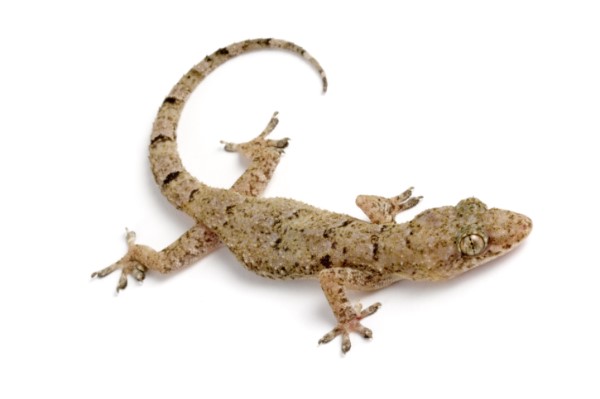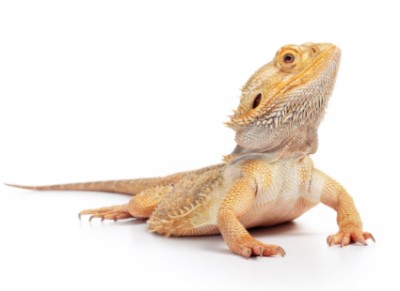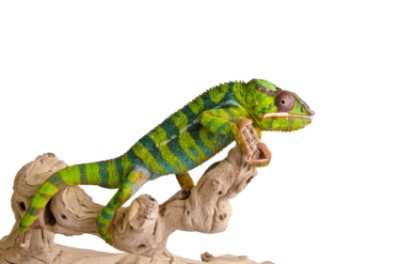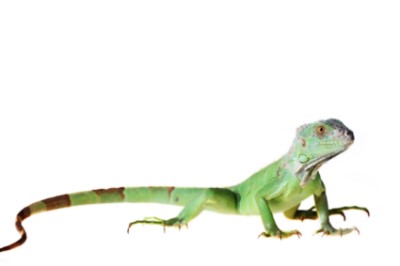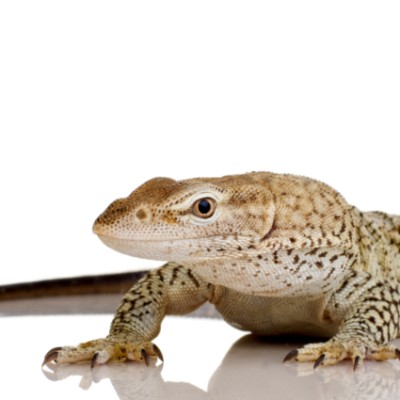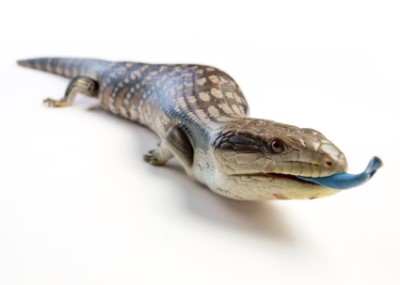Eyelid Geckos: These geckos are generally ground animals that live in rock crevices and burrows, and don’t have sticky pads on toes, but actually have claws. While this gecko cannot climb glass, he can be handled. The popular leopard gecko is in this group.
True Geckos: True geckos can be in any environment. They have sticky pads on their toes and run up glass as easily as they can run across the ground. Many are tree dwelling reptiles and tend to do better in tall tanks where they can climb. Catching geckos is a work of patience because they’re all fast as lightning. Bigger true geckos can be snappy, but if you work with them, they will handle better. The true gecko, has immovable eyelids, but is protected by a clear piece of skin that is like a lens over the eye. This eyelid is shed whenever the gecko sheds the rest of its skin periodically.
Day Geckos: Day geckos also have the sticky pads on their feet and can climb glass. The difference between the day and the true gecko is that the day geckos are active during the day, but true geckos cruise only at night.
For first time lizard owners, the best geckos are the leopard, crested, and fat tailed geckos.
Common Reasons for Surrender
Rescuers say that geckos are surrendered just because people lose interest or their children move off to college.
Pros
The gecko is a great starter reptile for children, even a classroom of children, as long as there is adult supervision. This lizard is not care intensive, can be handled, and is good with children old enough to heed directions on handling. Geckos are quick and difficult to catch—and if you grab one by the tail chances are her tail will come off. This lizard walks across walls and ceilings and is fun to watch, but needs a butterfly net to catch him.
Cons
The larger species of geckos, such as the Tokay geckos of Southeast Asia, can be vicious and bite. If you attempt to feed this lizard by hand, she may unwittingly split your fingernail in half with her vice grip jaws and sharp teeth.
Diet
The gecko lizard eats insects and the younger ones need to be fed one time daily or every other day, depending on the lizard. Water is provided by droplet lickers so it’s vital to mist the tank or use drip water. The leopard geckos drink very little and a small water dish shallow is enough. True geckos will drink droplets but some from the water dish, too.
Exercise
If this lizard is provided spacious housing in the proper climate, he will happily thrive on periods of intense running about.
Possible Health Issues
Watch for shedding difficulties with all three species of geckos. It can be difficult for the gecko to shed her skin, especially around her toes. The best way to help the gecko shed is to give him extra humidity by misting the tank. The leopard gecko (or eyelid geckos) will need a humidified hiding spot, a place to get underneath and keep the sand or bark mulch substrate damp under that place.
Housing
Geckos are territorial and you can’t combine males with males. Most will do well if you pair a male and female together. Sometimes they will breed. The tank needs to be at least a 40 gallon size, preferably larger. You can use limestone or calcite sand on the bottom of the tank, a type of sand that is digestible if the lizard accidentally picks up some of the sand while eating. Be sure to research your species of gecko to find out if your species wants a dry environment or needs humidity. If your gecko needs humidity, you can use bark mulch as substrate flooring and spray it occasionally. This is particularly helpful when the gecko is shedding. Some geckos are active during the day and others at night. Eyelid and true geckos won’t need the UVA or UVB bulbs—a general fluorescent fish tank light will work for this lizard. Day geckos should have high humidity and the full UVA and UVB bulbs and a basking light on one side of the tank. Place a branch at an angle underneath the basking light so the gecko can bask on the hot side of the tank and cool off on the other side. Be sure live plants are non toxic.
Grooming
The nice thing about the leopard gecko is that he will find one spot in tank to go to the bathroom and that’s the only place he will go. You can treat that spot like a litter box and scoop out droppings. Other geckos may need more spot cleaning.
Training
The gecko cannot roll over or play fetch, but she can be trained to interact with her owner in a friendly manner.
Entertainment
Leopard geckos have quirky personalities. True geckos and day geckos are hilarious to watch as they cruise around the tank. It’s especially fun to watch the nocturnal geckos chase a moth around the tank. They can jump from the side of the cage, like an acrobat, and grab the moth in mid air.
We want to thank Lancaster Herpetological Society, Lancaster, Pennsylvania, for help with this profile.
